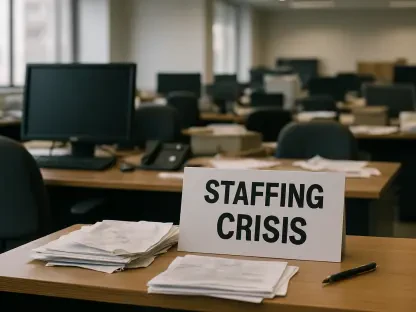As the winter months approach, workplaces brace for the inevitable wave of colds, flu, and other seasonal illnesses that sweep through offices and remote setups alike, creating significant challenges for employee health and productivity. However, the real issue lies not just in the spread of these ailments, but in the persistent culture of presenteeism—where employees feel compelled to work despite being unwell. This phenomenon, often overlooked, poses a significant threat to productivity and employee well-being. Research indicates that the financial impact of working while sick is staggering, costing employers billions annually due to reduced efficiency and prolonged recovery times. With flu season looming, human resources (HR) departments must prioritize tackling this issue head-on. Addressing presenteeism is not merely about managing sick days; it’s about fostering a healthier, more sustainable work environment. This article explores key reasons and actionable steps for HR to combat presenteeism effectively during the colder months.
1. Understanding the Hidden Costs of Presenteeism
Presenteeism might seem like a minor issue compared to absenteeism, but its economic toll on businesses is profound. When employees come to work ill, their productivity often plummets, leading to errors, slower output, and a diminished capacity to perform tasks effectively. This not only impacts individual performance but can also delay team projects and lower overall workplace morale. The ripple effect extends to longer recovery periods, as pushing through illness without proper rest often worsens conditions, resulting in extended downtime later. Financially, the cost of reduced productivity and potential medical expenses for worsened health conditions adds up quickly. HR must recognize that allowing a culture where working while sick is normalized can create a vicious cycle of inefficiency. By quantifying these hidden costs, organizations can better appreciate the urgency of addressing this issue, especially as winter illnesses peak and the risk of contagion rises in shared workspaces.
Beyond the immediate financial impact, presenteeism also affects employee engagement and retention. Staff who feel pressured to work through illness may harbor resentment toward a workplace that appears to undervalue their health. This can lead to disengagement, higher turnover rates, and difficulty attracting top talent, as word spreads about an unsupportive culture. Moreover, the spread of illness in the office due to presenteeism can create a domino effect, sidelining entire teams and disrupting operations. HR professionals need to view this as a systemic issue rather than an individual one, understanding that a single employee’s decision to work while unwell can impact the broader organization. Winter, with its heightened risk of contagious illnesses, amplifies these concerns, making it a critical time to reassess policies. Building awareness of these broader consequences can help HR departments advocate for cultural shifts that prioritize health over short-term output, ultimately benefiting the company’s long-term stability.
2. Crafting Supportive Absence Policies
One of the most effective ways for HR to combat presenteeism is by ensuring that absence policies are clear, accessible, and supportive. Employees should feel confident that taking short-term sick leave is preferable to working at reduced capacity or risking a longer illness. Policies must be communicated regularly through multiple channels, such as employee handbooks, internal newsletters, and team meetings, to reinforce the company’s stance on health. This transparency helps dispel any misconceptions that taking time off is frowned upon. HR can also outline specific procedures for reporting illness, ensuring the process is straightforward and non-punitive. During winter, when colds and flu are rampant, reminding staff of these guidelines becomes even more crucial. A well-defined policy not only protects individual health but also sets a standard for workplace expectations, reducing the likelihood of employees feeling obligated to show up when unwell.
Additionally, HR should tailor policies to address the unique challenges of remote work, where the lines between rest and productivity often blur. Many remote employees might feel compelled to log in from bed when sick, mistakenly believing this counts as rest. Educating staff on the importance of complete disconnection during illness is vital to prevent burnout and ensure proper recovery. HR can distribute reminders through digital platforms or virtual town halls, emphasizing that working while ill—whether in-person or remotely—can prolong sickness and impact performance. Encouraging full rest before returning to work also minimizes the risk of spreading illness to colleagues, even in virtual settings through delayed recovery. As winter brings a surge in seasonal ailments, proactive communication about these expectations can help remote and hybrid teams maintain a healthy balance. This approach reinforces a culture of care, showing employees that their well-being matters regardless of where they work.
3. Leading by Example in Workplace Culture
The influence of managers and senior staff on workplace culture cannot be overstated when it comes to addressing presenteeism. When leaders take time off to recover from illness without hesitation, it sends a powerful message to employees that prioritizing health is acceptable and encouraged. This is particularly impactful for junior staff, who often emulate the behaviors they observe in their superiors. HR should actively encourage managers to model healthy practices, such as openly communicating when they are unwell and stepping away from work temporarily. During the winter months, when illness rates spike, these visible actions can help dismantle the stigma around taking sick leave. By fostering an environment where health takes precedence over constant availability, organizations can reduce the pressure on employees to push through discomfort, ultimately curbing the spread of presenteeism.
Furthermore, HR can support this cultural shift by providing training for managers on how to reinforce positive behaviors. Workshops or briefings can focus on recognizing signs of illness or stress in team members and responding with empathy rather than expecting continued work. Managers should also be equipped to have regular check-ins with staff about workload and well-being, creating safe spaces for employees to voice concerns. This proactive approach helps prevent presenteeism driven by mental health challenges, such as stress or burnout, which are just as detrimental as physical illness. As winter often exacerbates feelings of fatigue and anxiety due to shorter days and holiday pressures, such conversations become even more critical. Equipping leaders with these skills not only addresses immediate health concerns but also builds trust within teams, ensuring employees feel valued and supported in maintaining their overall well-being throughout the colder season.
4. Prioritizing Mental Health and Practical Changes
Presenteeism isn’t limited to physical illness; mental health struggles like stress, anxiety, and burnout also contribute significantly to reduced productivity. HR must ensure that line managers are trained to spot early warning signs, such as changes in behavior or performance, and initiate supportive conversations. Providing access to mental health resources, such as counseling services or stress management workshops, demonstrates a commitment to employee well-being. Encouraging openness about mental health challenges can foster a trusting environment where staff feel safe to seek help rather than soldier on. Especially during winter, when seasonal affective disorder and holiday-related stress can peak, these initiatives are essential. By addressing mental health proactively, HR can prevent the silent toll of presenteeism, ensuring employees are not just physically present but also mentally engaged in their roles.
In addition to mental health support, small practical changes can make a significant difference in reducing presenteeism. HR can promote habits like taking regular breaks, stepping away from screens, and adhering to contracted hours without after-hours email checks. Simple initiatives, such as encouraging lunch breaks away from desks or setting boundaries for evening communications, signal that health is a priority. These adjustments may seem minor, but they collectively contribute to a workplace culture that values rest and recovery. During the winter season, when energy levels often dip, such practices can help employees recharge and avoid working when unwell. By embedding these habits into daily routines, HR can enhance engagement and productivity, showing staff that their well-being is integral to the organization’s success. These efforts create a foundation for sustainable performance, even amidst seasonal challenges.
5. Reflecting on Past Efforts and Future Steps
Looking back, HR departments that tackled presenteeism head-on during past winter seasons often saw marked improvements in employee health and workplace morale. Initiatives like supportive sick leave policies, leadership modeling, and mental health programs proved effective in reducing the urge to work while unwell. Organizations that invested in training managers to recognize early signs of illness or burnout reported fewer instances of prolonged sickness and higher staff satisfaction. Practical changes, such as enforcing breaks and clear communication about rest, also played a crucial role in shifting cultural norms. Reflecting on these past successes highlighted the importance of consistent effort and adaptability in addressing this pervasive issue, especially during colder months when health risks were elevated.
Moving forward, HR should build on these lessons by integrating well-being into everyday practices rather than treating it as a seasonal concern. Developing cost-effective initiatives, such as internal training sessions or employee assistance programs, can sustain a culture of care without straining budgets. Regularly revisiting and updating absence policies to reflect evolving workforce needs will ensure they remain relevant. Encouraging ongoing dialogue about health—both physical and mental—can empower employees to prioritize recovery over presence. As future winters approach, HR must continue to champion these strategies, adapting them to new challenges and technologies. By fostering an environment where rest is valued as much as productivity, organizations can create lasting change, ensuring staff bring their best selves to work year-round.









